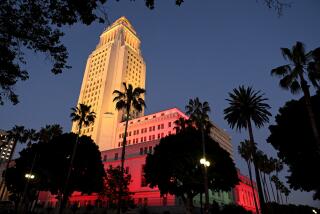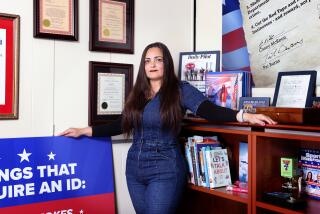City official gives up his Hummer in a race to City Hall
L.A.’s deputy mayor for transportation, Jaime de la Vega, was waiting for me at the top of the escalator at the Universal City train station Friday morning.
When I arrived, he handed me his keys, and the race to City Hall began.
De la Vega was taking the Red Line.
I would be driving his Hummer, so I guess you could say we’d both be traveling by locomotive.
“I’ll meet you in the City Hall rotunda,” De la Vega said.
I’ve spent three years kicking De la Vega around for being such a knucklehead and driving a gas-guzzling military-style vehicle in a city choked with traffic problems he’s supposed to be solving. Who does he think he is, Schwarzenegger?
He finally got the message and recently stopped driving the Hummer to work, instead carpooling with his wife in an Acura or using public transit. De la Vega says he made the decision on his own, but I hear that Mayor Villaraigosa finally got tired of the embarrassment and one of his minions gave De la Vega a nudge.
I can’t say I felt bad for De la Vega, who still uses the Hummer on weekends, but I did feel sorry for myself, not having the old gas hog to kick around anymore. Was there a way to squeeze just one more column out of it?
Sure there was. I suggested that I buy De la Vega’s Hummer and donate it to charity or the National Guard. But that would require a test drive, wouldn’t it? De la Vega decided to be a good sport about it.
So there we were at the starting line in Universal City, light rain falling. At precisely 8 a.m., he made a dash for the train and I hurried off to find his 2006 tank in the parking lot.
The H3 isn’t the largest Hummer and is no worse a guzzler than many other SUVs, including the one Villaraigosa gets ferried around in by his security detail. But it’s still a staggering heap of rolling metal, and I felt like a brigadier general in the National Guard.
Once I got over the Cahuenga Pass, traffic was crawling, and I pictured De la Vega hurtling past me underground. At rush hour, with light rain, I suspected he was going to win, and then he was going to harass me about my skepticism over the mayor’s current massive push for more rail.
We’d had a long discussion at City Hall earlier in the week in which De la Vega defended Villaraigosa’s transit initiatives against my skepticism.
Hey, I like trains and wish we could go on forever laying down more tracks. But rail is the most expensive transit to build. And in a horizontal city, it’s hard to imagine Westsiders, in particular, getting out of their cars unless their homes and offices are within two blocks of a train station and there’s a Starbucks along the way.
Draw a line across a map of L.A. and hundreds of thousands of residents live nowhere near that line. So the only way rail can work is to be part of an extensive network in which feeder buses serve train stations. And yet the MTA is now wrestling with historic budget shortfalls and the prospect of decreased service.
Will we end up with some shiny new trains but a decimated system we can’t afford to operate?
De la Vega conceded that Los Angeles poses unique challenges and, yeah, there are no easy answers to the budget deficit. But in 2008, L.A. County voters approved Measure R, the 30-year half-cent sales tax that will raise billions for rail construction. It will also pay for some bus operation and highway projects and create tens of thousands of jobs.
Here’s the deal, though. I was barely moving on the 101 south around Sunset. I’m betting that 10 years and billions of dollars down the road, traffic will be no better and might even be worse because of population growth.
The only thing that could ease congestion, if that’s the goal, would be to back up the investment in trains and buses by then enticing people out of their cars. How? By making motorists pay the true cost of driving, as many visionary leaders around the world have done.
That means raising the gas tax to fund transportation alternatives, getting rid of free parking, electronically charging motorists for adding to rush-hour congestion, offering incentives to employers who allow flexible starting times, getting at least halfway serious about bike lanes and maybe even using a license plate number system to keep each car off the road once every 10 days.
Inconvenient? Yes.
Popular? No.
But the truth is that those measures would work, and even De la Vega knows that.
It would be nice to hear him, or the mayor and other MTA board members, be honest with people and then lead the way.
Speaking of leading the way, I exited the slow crawl on the 101 at Broadway figuring De la Vega was already waiting for me at City Hall. And I was right.
He’d arrived at 8:30, the winner by about 10 minutes, and he was yammering about the wonders of rail.
We haven’t agreed on a price yet for the Hummer, so if you’d like to make Mr. De la Vega an offer he can’t refuse, feel free.
It handles nicely for a vehicle the size of the convention center. I must admit that I felt like a dope driving it, but I had an inflated sense of power, too, and a burning desire to run for governor.
More to Read
Sign up for Essential California
The most important California stories and recommendations in your inbox every morning.
You may occasionally receive promotional content from the Los Angeles Times.











